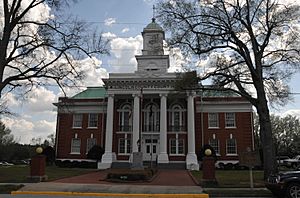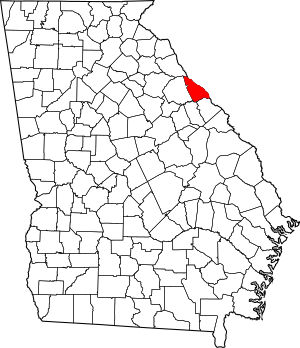Lincoln County, Georgia facts for kids
Quick facts for kids
Lincoln County
|
|
|---|---|

Lincoln County Courthouse in Lincolnton
|
|

Location within the U.S. state of Georgia
|
|
 Georgia's location within the U.S. |
|
| Country | |
| State | |
| Founded | February 20, 1796 |
| Named for | Benjamin Lincoln |
| Seat | Lincolnton |
| Largest city | Lincolnton |
| Area | |
| • Total | 257 sq mi (670 km2) |
| • Land | 210 sq mi (500 km2) |
| • Water | 47 sq mi (120 km2) 18.2%% |
| Population
(2020)
|
|
| • Total | 7,690 |
| • Estimate
(2023)
|
7,879 |
| • Density | 29.92/sq mi (11.553/km2) |
| Time zone | UTC−5 (Eastern) |
| • Summer (DST) | UTC−4 (EDT) |
| Congressional district | 10th |
Lincoln County is a county located in the east central portion of the U.S. state of Georgia. As of the 2020 census, the population was 7,690. The county seat is Lincolnton. The county was created on February 20, 1796. Lincoln County is included in the Augusta-Richmond County, GA-SC metropolitan statistical area, the Savannah River forming its northeastern border. Located above the fall line, it is part of the Central Savannah River Area (CSRA) and a member of the CSRA Regional Development Center.
Contents
History
On February 20, 1796, Lincoln County was established as the twenty-fourth county in the state of Georgia. Before then, its territory was part of Wilkes County, now on its western side. The new county was named after General Benjamin Lincoln (1733-1810), a Revolutionary War hero notable for receiving Gen. Cornwallis's sword at Yorktown, Virginia.
On January 22, 1852, the legislature changed the location of the line between Wilkes County and Lincoln County, although there is no extant record as to why the legislature made the change.
From before the American Revolutionary War until the 1950s, Lincoln County was primarily a farming and agricultural area. The development and creation of Clarks Hill Dam created a large reservoir that covered portions of Lincoln and nearby counties. Developers have created many residential neighborhoods and subdivisions in areas near the lake.
Geography
According to the U.S. Census Bureau, the county has a total area of 257 square miles (670 km2), of which 210 square miles (540 km2) is land and 47 square miles (120 km2) (18.2%) is water. The county is located in the Piedmont region of the state just above the fall line of the eastern United States.
The bulk of Lincoln County, from just south of Lincolnton heading north, is located in the Upper Savannah River sub-basin of the Savannah River basin, with the exception of a tiny sliver of the northernmost section of the county, which is located in the Broad River sub-basin of the larger Savannah River basin. The southern portion of the county is located in the Little River sub-basin of the same Savannah River basin.
Major highways
 U.S. Route 378
U.S. Route 378 State Route 43
State Route 43 State Route 43 Connector
State Route 43 Connector State Route 44
State Route 44 State Route 47
State Route 47 State Route 79
State Route 79 State Route 220
State Route 220
Adjacent counties
- Elbert County, Georgia - north
- McCormick County, South Carolina - northeast
- Columbia County, Georgia - south
- McDuffie County, Georgia - southwest
- Wilkes County, Georgia - west
Communities
City
Unincorporated community
Demographics
| Historical population | |||
|---|---|---|---|
| Census | Pop. | %± | |
| 1800 | 4,766 | — | |
| 1810 | 4,555 | −4.4% | |
| 1820 | 6,458 | 41.8% | |
| 1830 | 6,145 | −4.8% | |
| 1840 | 5,895 | −4.1% | |
| 1850 | 5,998 | 1.7% | |
| 1860 | 5,466 | −8.9% | |
| 1870 | 5,413 | −1.0% | |
| 1880 | 6,412 | 18.5% | |
| 1890 | 6,146 | −4.1% | |
| 1900 | 7,156 | 16.4% | |
| 1910 | 8,714 | 21.8% | |
| 1920 | 9,739 | 11.8% | |
| 1930 | 7,847 | −19.4% | |
| 1940 | 7,042 | −10.3% | |
| 1950 | 6,462 | −8.2% | |
| 1960 | 5,906 | −8.6% | |
| 1970 | 5,895 | −0.2% | |
| 1980 | 6,716 | 13.9% | |
| 1990 | 7,442 | 10.8% | |
| 2000 | 8,348 | 12.2% | |
| 2010 | 7,996 | −4.2% | |
| 2020 | 7,690 | −3.8% | |
| 2023 (est.) | 7,879 | −1.5% | |
| U.S. Decennial Census 1790-1880 1890-1910 1920-1930 1930-1940 1940-1950 1960-1980 1980-2000 2010 |
|||
| Race | Num. | Perc. |
|---|---|---|
| White | 5,196 | 67.57% |
| Black or African American | 2,116 | 27.52% |
| Native American | 18 | 0.23% |
| Asian | 20 | 0.26% |
| Pacific Islander | 3 | 0.04% |
| Other/Mixed | 245 | 3.19% |
| Hispanic or Latino | 92 | 1.2% |
As of the 2020 United States census, there were 7,690 people, 3,475 households, and 2,142 families residing in the county.
Recreation and historical sites
Since the creation of Clarks Hill Lake, recreation has contributed to Lincoln County's growth. It is a main destination for tourists, providing fishing, boating, and other water sports opportunities for visitors and nearby residents.
Toward the eastern part of Lincoln County, just before the South Carolina line, is Elijah Clarke State Park. This park is roughly 447 acres (1.81 km2). In May of every year, Elijah Clarke holds a bluegrass festival which has become a major attraction in the last 20 years. Several well-known bluegrass musicians play at this event each year, including Lincoln County natives, The Lewis Family. Also held annually at Elijah Clarke is an Arts and Crafts Festival and a Log Cabin Christmas.
There are many historic places to visit in Lincoln County. They include:
- Lamar-Blanchard House, Lincolnton, which is on the National Register of Historic Places
- The Lincoln County Historical Park
- Graves Mountain
Economy
Economic growth has been associated with development of the J. Strom Thurmond Dam and Clarks Hill Lake. In Lincoln County, logging is a multimillion-dollar industry. More than 20 logging businesses produce most of the jobs for Lincoln County residents. The county is also home to Back Paddle Brewing, a veteran owned craft brewery.
Notable people
- Garrison Hearst- Former NFL player, pro bowler, comeback player in 1995 and 2001
- Barney Bussey - Former NFL player, played for the Cincinnati Bengals and then the Tampa Bay Buccaneers
- The Lewis Family - family bluegrass and gospel band, in 1992 they were inducted into Georgia Music Hall of Fame
- Tom Nash - NFL player for the Green Bay Packers and Brooklyn Dodgers
See also
 In Spanish: Condado de Lincoln (Georgia) para niños
In Spanish: Condado de Lincoln (Georgia) para niños

